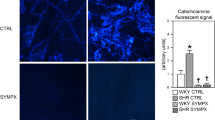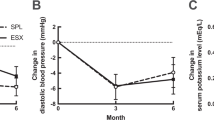Abstract
ANIMAL experimental models of high blood pressure as caused, for example, by renal artery constriction or administration of mineralocorticoid hormones and salt, have yielded basic data on physiological processes which have helped in the diagnosis and treatment of human hypertension. The discovery that ACTH administration causes a reproducible hypertension of rapid onset in the sheep provided a new model for analysis1,2. Certain clinical observations have indicated that there may be as yet unidentified steroids which are causally involved in some hypertensive states: for example, instances of high blood pressure in children and adults which were corrected by dexamethasone treatment3,4, and reversal of high blood pressure in the low renin group of essential hypertensives by inhibitors of steroidogenesis or by spironolactone have been described4–6. We report here the hypertensive effect of 17α, 20α-dihydroxyprogesterone (17α, 20α-diOHP; 17α, 20α-dihydroxy-4-pregnene-3-one) and 17α-hydroxyprogesterone(17α-OHP) in sheep made hypertensive with ACTH. These two progesterones were identified in the adrenal venous effluent from ACTH-hypertensive sheep and were shown to be secreted in greatly increased amounts.
This is a preview of subscription content, access via your institution
Access options
Subscribe to this journal
Receive 51 print issues and online access
$199.00 per year
only $3.90 per issue
Buy this article
- Purchase on Springer Link
- Instant access to full article PDF
Prices may be subject to local taxes which are calculated during checkout
Similar content being viewed by others
References
Scoggins, B. A., et al., Am. J. Physiol., 226,198 (1974).
Fan, J. S. K., et al., Am. J. Physiol., 228, 1695 (1975).
New, M. I., Saenger, P. H., Peterson, R. E., and Ulick, S., Bull. N.Y. Acad. Med., 51, 1179 (1975).
Melby, J. C., Dale, S. L., Grekin, R. J., Gaunt, R., and Wilson, T. E., Rec. Prog. Hormone Res., 28, 287 (1972).
Woods, J. W., Liddle, G. W., Stant, E. G., Michelakis, A. M., and Brill, A. G., Arch. intern. Med., 123, 366 (1969).
Gunnells, J. C., et al., Ann. intern. Med., 73, 901 (1970).
Wright, R. D., et al., Austr. J. exp. Biol. med. Sci., 50, 873 (1972).
Blair-West, J. R., et al., Endocrinology, 71, 990 (1962).
Coghlan, J. P., et al., Proc. 4th Mtg. Int. Soc. Hypertension, Sydney, February 1976, 22 (National Heart Foundation of Australia, 1976).
Sennett, J. A., et al., Circulation Res., 36, Suppl. 1, 2 (1975).
Oliver, J. T., Birmingham, M. K., Butova, A., Li, M. P., and Chan, T. H., Science, 182, 1249 (1973).
Author information
Authors and Affiliations
Rights and permissions
About this article
Cite this article
COGHLAN, J., DENTON, D., FAN, J. et al. Hypertensive effect of 17α, 20α7–dihydroxyprogesterone and 17α-hydroxyprogesterone in the sheep. Nature 263, 608–609 (1976). https://doi.org/10.1038/263608a0
Received:
Accepted:
Issue Date:
DOI: https://doi.org/10.1038/263608a0
This article is cited by
-
Aldosterone and dopamine receptors in the kidney: Sites for pharmacologic manipulation of renal function
Kidney International (1980)
Comments
By submitting a comment you agree to abide by our Terms and Community Guidelines. If you find something abusive or that does not comply with our terms or guidelines please flag it as inappropriate.



